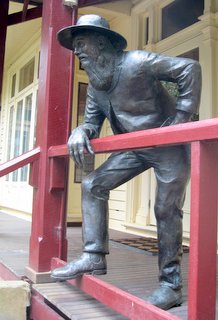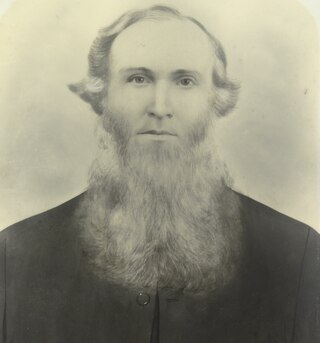
"The Man From Ironbark" is a poem by Australian bush poet Banjo Paterson. It is written in the iambic heptameter.
"Saint Peter" is a well-known poem by iconic Australian writer and poet Henry Lawson. It was first published on 8 April 1893 in The Bulletin.
"Up The Country" is a popular poem by iconic Australian writer and poet Henry Lawson. It was first published in The Bulletin magazine on 9 July 1892, under the title "Borderland." Its publication marked the start of the Bulletin Debate, a series of poems by both Lawson and Andrew Barton "Banjo" Paterson asserting contrasting views of the true nature of life in the Australian bush.

Charles Harpur was an Australian poet and playwright. He is regarded as "Australia's most important nineteenth-century poet."
The City Bushman is a poem by iconic Australian writer and poet Henry Lawson. It was first published in The Bulletin magazine on 6 August 1892, under the title In Answer to "Banjo", and Otherwise. It was the fourth work in the Bulletin Debate, a series of poems by both Lawson and Andrew Barton "Banjo" Paterson, and others, about the true nature of life in the Australian bush.
"The Creek of the Four Graves" is a poem by Australian writer Charles Harpur that was first published in three parts in The Weekly Register of Politics, Facts and General Literature on 9 August, 16 August and 23 August 1845.
Saltbush Bill is a humorous poem by Australian writer and poet Andrew Barton "Banjo" Paterson. It was first published in The Bulletin magazine on 15 December 1894, the Christmas issue of that publication.
A Mid-Summer Noon in the Australian Forest is a poem by Australian poet Charles Harpur. It was first published in The Empire magazine on 27 May 1851, and later in the poet's collection titled Poems (1883).
"A Death in the Bush" (1868) is a long narrative poem by Australian poet Henry Kendall. It was originally published in the 1868 edition of Williams's Illustrated Australian Annual, and later appeared in the author's collection Leaves from Australian Forests (1869).
"The Song of Old Joe Swallow" (1890) is a poem by Australian poet Henry Lawson.
"The Old Bush Road" (1892) (aka is a poem by Australian poet Jennings Carmichael.
"The Buried Chief" (1886) is a poem by Australian poet Henry Parkes.
"The Crane is My Neighbour" (1938) is a poem by Australian poet John Shaw Neilson.
"The Fire at Ross's Farm" (1890) is a poem by Australian poet Henry Lawson.
"A Bushman's Song" (1892) is a poem by Australian poet A. B. Paterson.
"The Roaring Days" (1889) is a poem by Australian poet Henry Lawson.
"South of My Days" (1945) is a poem by Australian poet Judith Wright.
"A Coast View" (1857) is a poem by Australian poet Charles Harpur, also known by the title "Coast Scenery".
"The Beautiful Squatter" (1845) is a poem by Australian poet Charles Harpur.
"Middleton's Rouseabout" is a poem by Australian poet Henry Lawson. It was first published in The Freeman's Journal on 8 March 1890, and later in the poet's collections and other Australian poetry anthologies.

